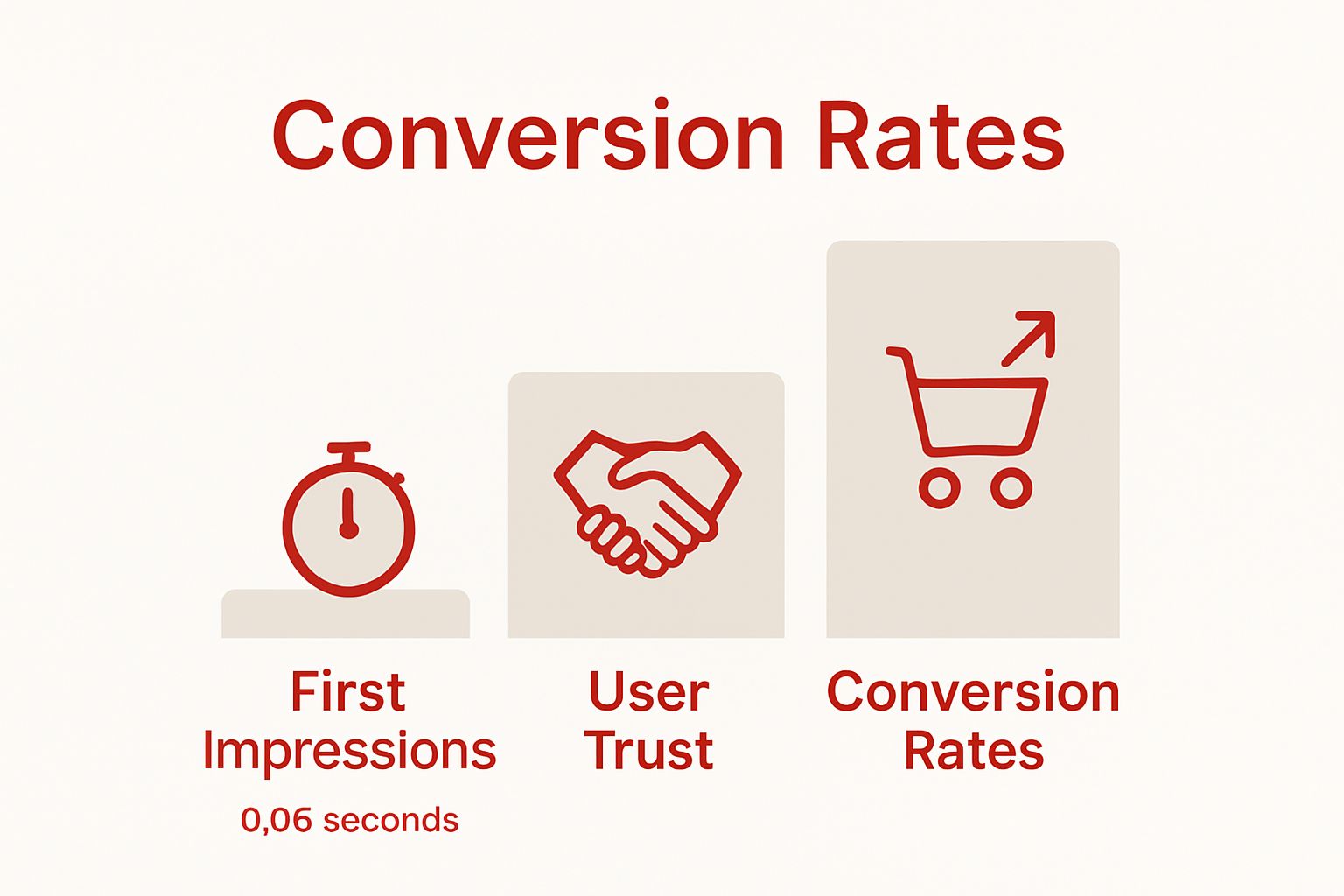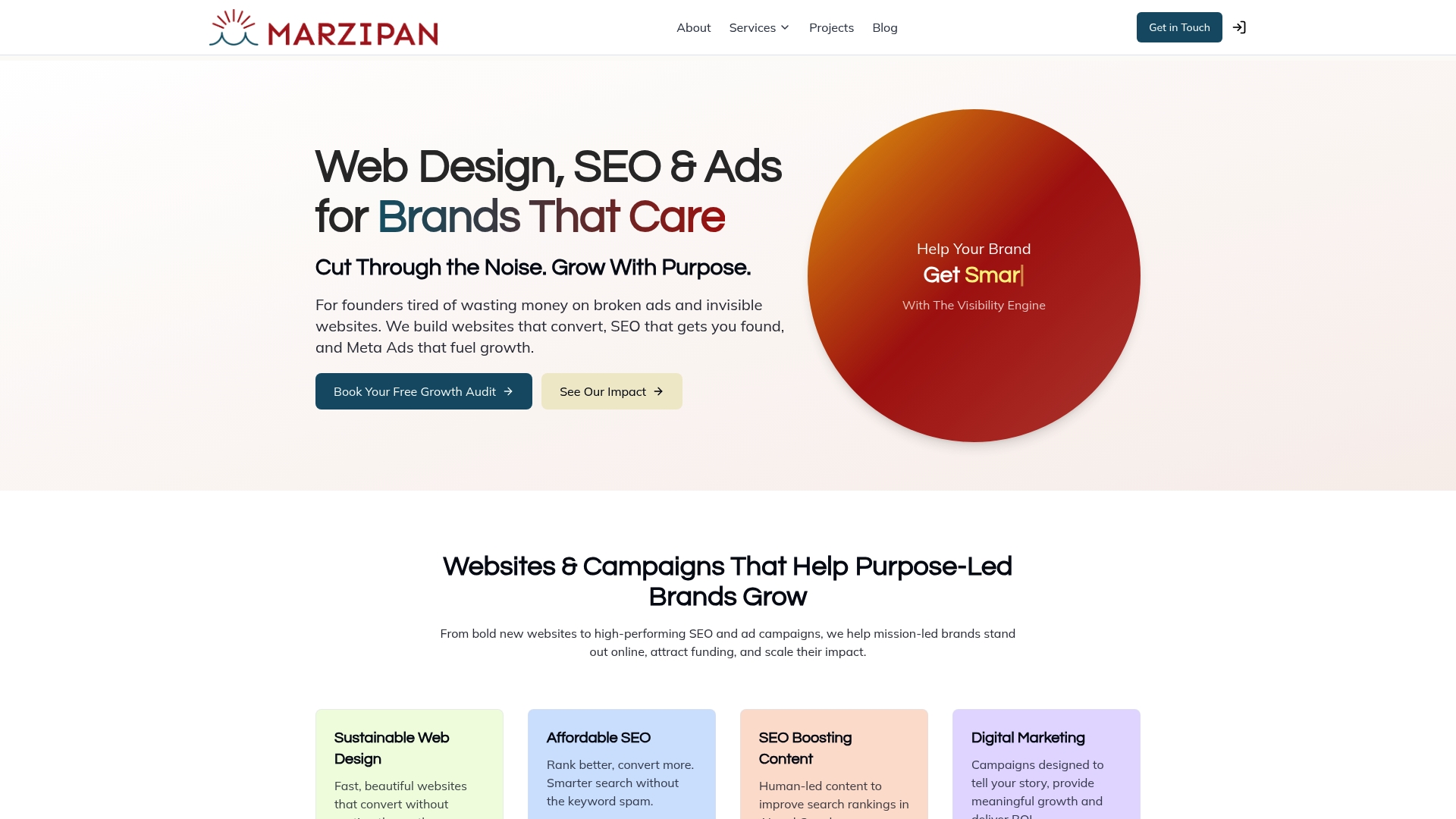Understanding Why Web Design Matters for Businesses
Web design sits at the heart of every digital experience you encounter. Users form their initial impression of a website within just 0.05 seconds. Most people focus on bold colours and striking layouts, expecting these alone to win over visitors. What they miss is that the real success of web design goes far deeper than looks. There is a hidden science shaping everything you see and touch online.
Table of Contents
- What Is Web Design And Its Fundamental Principles?
- Why Web Design Is Crucial For Brand Success
- How Web Design Influences User Experience
- Key Elements That Shape Effective Web Design
- The Evolving Role Of Web Design In Digital Strategy
Quick Summary
| Takeaway | Explanation |
|---|---|
| Effective design captures attention quickly | Users form first impressions of websites in just 0.05 seconds, highlighting the need for engaging visual elements. |
| Responsive design is essential | Websites must adapt to various devices and screen sizes, employing flexible layouts and media queries for optimal performance. |
| Visual credibility fosters trust | Professional colour schemes, high-quality imagery, and intuitive layouts reinforce brand identity and establish user trust. |
| User experience reduces cognitive load | Clear site architecture and predictable navigation help users find information quickly, enhancing overall satisfaction. |
| Web design aligns with business goals | Strategic design supports marketing and user engagement, ensuring the website meets the objectives of the company effectively. |
What is Web Design and Its Fundamental Principles?
Web design represents the comprehensive process of conceptualising, planning, and creating digital experiences through visual, functional, and interactive website elements. Our comprehensive guide on web design explores this intricate discipline that blends artistic creativity with technical functionality.
Visual Elements and User Experience
At its core, web design involves crafting digital interfaces that communicate effectively and engage users instantaneously. Professional web designers integrate multiple components to create cohesive online experiences:
- Colour palettes that reflect brand identity
- Typography that enhances readability
- Strategic layout designs
- Interactive navigation structures
Designers must balance aesthetic appeal with functional performance, ensuring websites not only look attractive but also provide seamless user interactions. According to Nielsen Norman Group research, users form initial impressions within 0.05 seconds, underscoring the critical importance of thoughtful design.
Technical Foundations of Effective Design
Successful web design transcends visual appeal, incorporating technical principles that ensure optimal performance. Responsive design has become fundamental, allowing websites to adapt seamlessly across various devices and screen sizes. This approach involves creating fluid grid layouts, flexible images, and media queries that adjust content presentation dynamically.
Technical considerations include:
- Page loading speed
- Cross browser compatibility
- Mobile responsiveness
- Intuitive user interface design
Effective web design integrates aesthetic principles with robust technical infrastructure, creating digital experiences that are both visually compelling and functionally superior.
To clarify the two sides of web design discussed in this section — visual and technical — the following table delineates their distinct features and roles.
| Aspect | Visual Elements | Technical Foundations |
|---|---|---|
| Primary Focus | Crafting appealing, engaging digital interfaces | Ensuring robust, high-performing technical structures |
| Key Components | Colour palettes, typography, strategic layout, navigation | Page speed, cross-browser compatibility, mobile responsiveness |
| Objective | Create memorable first impressions and user engagement | Support flexible, accessible, and seamless user experiences |
| Typical Activities | Design look and feel, visual hierarchy, branding | Responsive grid layouts, flexible media, intuitive UI |
| Impact | Reinforces brand identity and emotional response | Enhances usability, reliability, and device adaptability |
Why Web Design is Crucial for Brand Success
Web design serves as a powerful strategic tool that significantly impacts how businesses communicate their brand identity, values, and professionalism in the digital landscape. Learn more about our website branding process to understand how strategic design transforms online presence.
First Impressions and Visual Credibility
In the digital realm, a website acts as the primary touchpoint for potential customers, functioning as a virtual storefront that represents a company’s brand personality. According to research on consumer trust, users form critical judgments about a business within milliseconds of landing on a website.

Key elements that establish visual credibility include:
- Professional colour schemes
- High-quality imagery
- Consistent brand messaging
- Clean, intuitive design layouts
Strategic Brand Communication
Effective web design transforms websites from mere informational platforms into powerful brand communication tools. Every design element communicates subtle messages about a company’s values, professionalism, and commitment to quality. Businesses that invest in strategic web design demonstrate:
- Understanding of modern digital expectations
- Commitment to user experience
- Technological sophistication
- Strong brand positioning
A well-crafted website becomes more than an online presence it represents a comprehensive brand narrative that engages and converts potential customers through thoughtful, intentional design choices.

How Web Design Influences User Experience
User experience represents the holistic interaction between website visitors and digital platforms, where web design plays a pivotal role in creating intuitive, engaging, and meaningful digital encounters. Our comprehensive environmental website design guide explores how thoughtful design transforms user interactions.
Navigation and Cognitive Ease
Web design directly impacts how users process information and navigate digital spaces. An intelligently structured website reduces cognitive load, allowing users to find information quickly and effortlessly. According to research from CSIRO, user experience is fundamentally influenced by:
- Clarity of site architecture
- Predictable menu structures
- Logical information hierarchy
- Intuitive interaction pathways
Designers must create pathways that feel natural and anticipate user expectations, minimising confusion and frustration.
Emotional and Psychological Response
Beyond functional navigation, web design triggers profound psychological responses. Colour schemes, typography, imagery, and layout combine to evoke specific emotional reactions that can significantly influence user engagement and perception.
Key psychological design considerations include:
- Colour psychology and emotional triggers
- Visual hierarchy that guides attention
- Consistent brand representation
- Balanced use of whitespace
Successful web design transforms digital interactions from mere transactions into meaningful, memorable experiences that resonate with users on both rational and emotional levels.
Key Elements that Shape Effective Web Design
Web design combines strategic visual communication with technical functionality, creating digital experiences that engage, inform, and convert users. Explore our guide to future proof web design to understand how innovative design principles transform online platforms.
Visual Composition and Brand Identity
The visual elements of web design serve as the primary language of communication, translating brand personality into tangible digital experiences. Designers meticulously craft visual components to create cohesive and compelling narratives that resonate with target audiences.
Critical visual design elements include:
- Consistent colour palettes
- Strategic typography selection
- Balanced negative and positive spaces
- High quality, purposeful imagery
These visual components work synergistically to establish brand recognition, communicate values, and create emotional connections with website visitors.
Functional Design and Technical Performance
Beyond aesthetic considerations, effective web design demands robust technical infrastructure that ensures seamless user interactions. According to international design standards research, successful web design integrates multiple performance metrics:
- Rapid page loading speeds
- Responsive mobile compatibility
- Cross browser functionality
- Accessibility compliance
Technical design considerations transform websites from static information repositories into dynamic, interactive platforms that adapt to user needs and technological advancements.
This table summarises the key elements that shape an effective web design, categorising them into visual and functional components as described in the article.
| Design Element Category | Examples from Content | Purpose |
|---|---|---|
| Visual Composition | Consistent colour palettes, strategic typography, high quality imagery | To establish brand recognition and create emotional connections |
| Brand Identity | Balanced positive/negative space, cohesive narratives | To communicate values and reinforce brand personality |
| Functional Design | Rapid page loading, responsive compatibility, accessibility | To ensure seamless user interaction and technical reliability |
| Technical Performance | Cross-browser functionality, mobile responsiveness | To adapt to technology and changing user needs |
The Evolving Role of Web Design in Digital Strategy
Web design has transformed from a purely aesthetic discipline into a critical strategic component of digital business communication and user engagement. Discover our comprehensive guide to understanding web design functionality to appreciate the profound strategic implications of modern digital platforms.
Strategic Business Communication
Today’s web design transcends visual presentation, functioning as a sophisticated communication channel that directly influences business objectives. Websites now serve as dynamic platforms that integrate marketing, sales, customer service, and brand storytelling into a cohesive digital experience.
Strategic web design elements include:
- Alignment with business goals
- Data driven design decisions
- Conversion rate optimization
- Performance tracking mechanisms
Businesses recognise that their digital presence is no longer optional but a fundamental mechanism for connecting with audiences, driving engagement, and generating measurable commercial outcomes.
Technological Adaptation and Innovation
Web design continually evolves in response to technological advancements and changing user expectations. According to international digital transformation research, successful digital strategies require continuous innovation and adaptive design approaches.
Key technological considerations encompass:
- Artificial intelligence integration
- Advanced responsive design techniques
- Personalisation capabilities
- Enhanced accessibility standards
Modern web design represents a sophisticated intersection of technology, psychology, and strategic communication, enabling businesses to create meaningful digital experiences that resonate with increasingly sophisticated online audiences.
Unlock the Power of Strategic Web Design for Your Mission-Led Business
Are you worried your website fails to reflect your brand or to capture attention quickly enough? As explained in our article, users judge your business in an instant. Effective web design blends visual appeal, consistent branding, fast performance and clear user pathways. When you neglect seamless navigation or mobile responsiveness, you risk losing trust and credibility with your audience. At Marzipan, we understand how much effective web design matters for businesses. Our expertise lies in building sustainable websites tailored for mission-led brands who care about both impact and growth.

Now is the time to ensure your digital presence works as hard as you do. Discover how our belief in responsive, accessible design and ethical SEO can help you earn trust and capture more leads. Learn more about our sustainable web solutions or connect with us directly through our website for a free consultation. Your next step towards a powerful online presence starts here.
Frequently Asked Questions
What are the fundamental principles of effective web design?
Effective web design hinges on a balance of visual appeal and technical functionality. Key principles include intuitive navigation, responsive design, aesthetic consistency, and optimal page loading speeds.
How does web design impact user experience?
Web design significantly influences user experience by facilitating easy navigation and reducing cognitive load. An intuitive layout helps users find information quickly, while thoughtful design elements create emotional connections and enhance engagement.
Why is first impression important in web design for businesses?
First impressions are crucial as users make judgments about a business in milliseconds upon visiting a website. Professional design elements establish visual credibility and reflect the brand’s personality, impacting user trust and engagement.
How does web design contribute to brand communication?
Web design serves as a strategic tool for brand communication by conveying a company’s values and professionalism. Each design element, from colour schemes to layout, contributes to a cohesive brand narrative that can engage and convert visitors.







